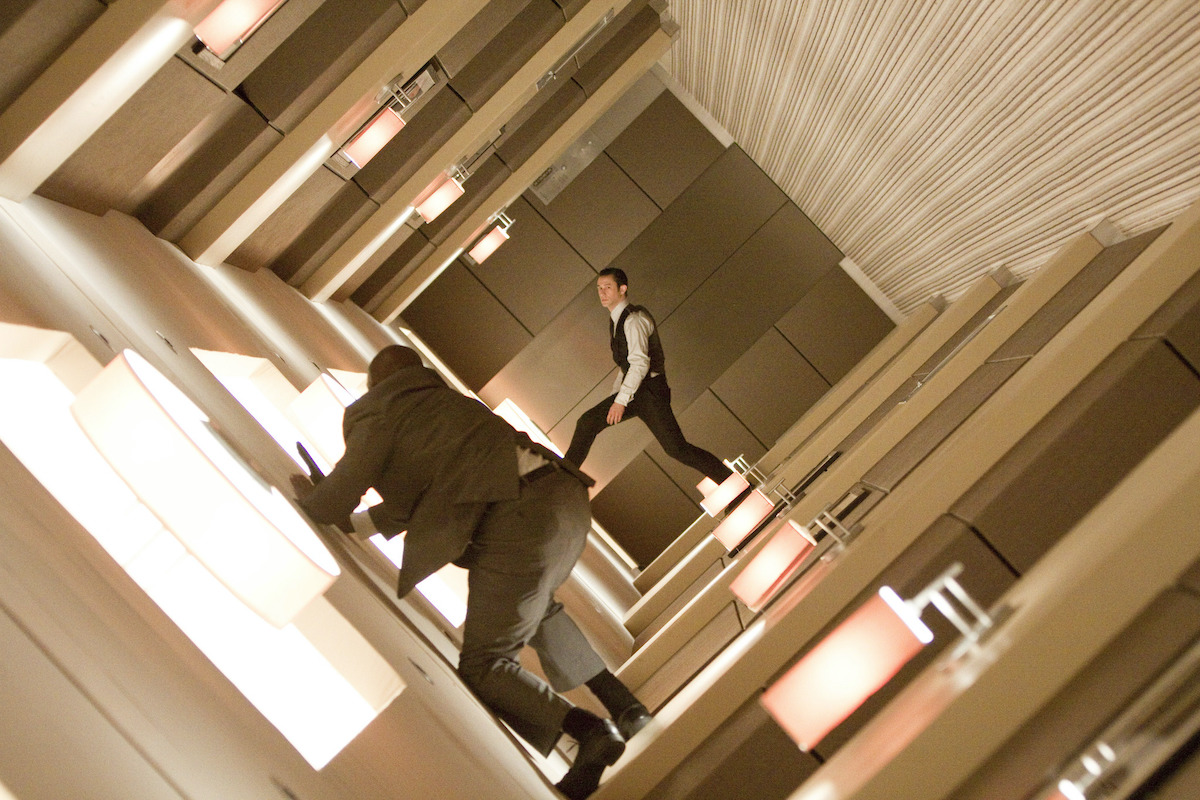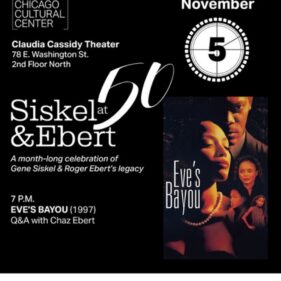Perhaps Richard Roeper planted an inception (the idea that movie theaters are still the best way to see a film even during the pandemic) in my head a few weeks ago when he wrote about going to see a film at the Music Box Theatre in Chicago. I was agog when I read it. He actually went to the theater even though there are no proven vaccines or readily available treatments for the coronavirus! At that point, I was still too traumatized at the thought of catching COVID-19 and ending up on a ventilator to even think of stepping outside of my bubble to attend a public movie with other audience members. What kind of hygienic steps were they taking? Did they disinfect the seats and restrooms? Were they testing their employees or at least taking their temperatures and making them wear gloves? Were they using sanitizers? Would I and everyone else have to wear masks the whole time? And more important, what kind of steps were they taking to make sure there was no recirculated “CORONA” air wafting throughout the theater?
I could see my way clear to attending one of the drive-in theaters newly mushrooming across the country after reading Matt Fagerholm’s article. At least you stay in your own car and breath free flowing outside air and can even take your own goodies if you are too timid to approach the concession stand. But something was compelling about Richard’s article. He had a good time at the movies watching it communally with others and said he would go back as long as they continued to limit the number of attendees. Yet, at that time, I concluded that it would probably be months or even next year before I stepped foot in a theater again. So it was with utter amazement that I found myself last Friday afternoon in mid-August, sitting in the Music Box Theatre watching Christopher Nolan’s film “Inception.” And I have to admit it was a pretty awesome experience, and I had definitely found my happy place for the day.
From the time I devoured Richard’s article, the small idea he planted in my brain grew. Much like the idea Leonardo DiCaprio had to plant in the brain of the scion of an industrialist in “Inception,” which was celebrating its tenth anniversary with a live showing in 70mm. The idea of going to a movie theater was buffeted by our site’s managing editor, Brian Tallerico, even though Brian concluded he would watch it at home rather than take a chance on becoming anxious with every sniffle and sneeze if he went to the theater. Brian exclaimed, “The reason it’s easy to get carried away by ‘Inception’ is simple: it’s one of the most propulsive major blockbusters in history.” (emphasis mine).
I laced up my sneakers and headed out! That is, after going online to purchase a ticket for the 1pm showing. I didn’t want to take a chance on going later when the theater was surely to contain more people. Although Brian’s description of Nolan’s ten year old film made me want to see it again, it was his statement about the theater reconfiguring their ventilation system so it doesn’t recycle air and only pushes in fresh air from outside that convinced me it was safe enough to venture out. I took a deep breath for courage and set out on my first movie outing since March.
There is something special about watching a Christopher Nolan film. From “Memento” to “Interstellar“, or the ‘Dark Knight” Batman movies and even “The Prestige”, Nolan’s movies draw me in. Whether or not you think his films are ultimately great or merely good, I appreciate the fact that they make me think and give me a worthwhile cinematic experience. Their complexity lets you know that the filmmaker is thinking about the storyline, sometimes it seems as if he is overthinking it, but I’d rather have that than one haphazardly thrown together.
And this time, another payoff for going to the theater was the treat of seeing footage from the making of “Tenet.” If the film is even half as exciting as that footage that was shot in several countries around the world, it will be a blockbuster. I don’t like making predictions like that based on what is essentially a trailer, but maybe I fell under the spell of being back in an actual movie theater. Or maybe it was listening to John David Washington, sounding like his father, Denzel. Or hearing Nolan talking about why he takes time to so meticulously set up the scenes so he can use as little CGI as possible since certain computer generated special effects don’t age well. Whatever the reason, I felt as if it was setting me up for another inception idea to return to the theater when “Tenet” opens. But I don’t want to get ahead of myself.
My first viewing of “Inception” ten years ago was not wholly satisfactory even though Roger awarded it four stars. I wanted to love it as much as he did, but I could not. “Inception” is about a corporate raider (played by Leonardo DiCaprio) who uses a combination of architecture and psychology to extract secrets hidden deep inside the recesses of one’s brain. Hold-on-a-minute, you may say. Yes, I know, not your ordinary plot. But Nolan is no ordinary director. In the film, this method, known as extraction, is apparently used more often than we think in both political and industrial espionage because none of the other characters seemed too surprised to be invited to participate in an extraction, which takes place during someone’s dream. Oh, and you can take five or six other people with you into the dream to perform it.
But that’s not all. The other thing a skilled psychological architect can do is plant, rather than extract, the idea or meme in one’s head in the first place. And this is where Nolan is a master. An inception isn’t supposed to be easy and for that reason almost no one attempts it according to the plot line. In fact, the film espouses rules of engagement that sound as if they are from a manual of an hypnotist or psychiatrist. For instance, the idea has to be one that the subject thinks is his from the beginning, not one that was forced on him by another. Also, once you’re in the dream state, you can’t encounter anything so out of the ordinary that it takes you out of the logical or even illogical construct of that particular dreamworld, or it could defeat the extraction or the inception. That makes sense to me. We all have had dreams where at some point we realized we were dreaming and so we began to perceive the world in that dream differently. Your mind either wakes up a bit, or you can force it to a deeper level.
Ten years ago, I expressed impatience about why the corporate raider needed an architectural student to help with the inception. Roger’s explanation did assuage my impatience. He asked, “Is it a coincidence that Ariadne (Ellen Page) is named for the woman in Greek mythology who helped Theseus escape from the Minotaur’s labyrinth?” And I was willing to accept Roger’s assertion that “…the movies often seem to come from the recycling bin…Sequels, remakes, franchises. ‘Inception’ does a difficult thing. It is wholly original, cut from new cloth, and yet structured with action movie basics so it feels like it makes more sense than (quite possibly) it does.”
So I just watched and accepted it on the cerebral level of the dreams and dismissed the action parts of it. Back then I wasn’t aware of the plot of going into dreams presented in “Paprika,” the anime by Satoshi Kon based on the novel by Yasutake Tsutsui. Roger concluded that when Nolan left the labyrinth he threw away the map. And back then that was enough for me.
A quick review of some of my growing up experiences may help understand why I focused on the dreamy aspects of the film the first time around. I grew up in a house with a mother who was a Minister in the Spiritualist Church. Mother was called a prophet, a seer, a psychic, and more. She never used her “gifts” in a commercial manner, but we, all of her children, knew there was something different about our Mom. She was highly intuitive and perceptive. But she was also the most loving, nurturing creature we knew. We said that when she walked into a room, she brought the sunshine with her. So all the woo-woo stuff was just part of the whole package that we loved and accepted.
When my sister Adele and I played school, we held one class where you had to go to different rooms and one person was tasked with drawing shapes or objects and the person in the other room had to receive the impressions telepathically or by remote viewing and reproduce them on a piece of paper. Back then we thought that was normal, didn’t every school child do this? Of course we found out the answer was no. The other thing we were encouraged to do was talk about our dreams so that we could learn how to distinguish the prophetic ones that would come true, from the ordinary dreams that were just images from our subconscious rearranging themselves in our brain.
We were taught about lucid dreaming, where you could go in and tell yourself you were dreaming and reconstruct the events or change the dream to achieve the outcome you desired. If you were plagued by a recurring nightmare where a lion was chasing you, for example, you could give yourself a signal to stop and face the lion and tell it you are not afraid, and it is only a dream and that you want it to stop chasing you forever. That lion may even become an ally in future dreams. But that particular nightmare will stop. Or if you have human adversaries with whom you cannot find an accommodation, you can face them and order a truce. They too may become an ally, right then and there.
On rare occasions, once you realize you are in a dream, you can surrender and coax yourself deeper into the dream. From that point, however, you must trust whatever may come afterwards. One doesn’t always have full control during lucid dreaming. But you learn to give yourself a clue to help you. You can tell yourself to look at your arm. Is it solid, can you pinch it? Or you can look for a mirror to see if you can see your reflection or the reflection of another. Or you can put your arms up in the air and just take off flying. Lucid dreaming can get really wild!
You learn that time is so fluid in a dream that five or ten minutes can seem like a whole day of activities. So watching some of the characters age in “Inception” felt so real. In fact, I had a dream where I lived for years with children who lived on another planet and thought they were bred in test tubes. I think I was some sort of scientist who watched them grow up. Although I didn’t initiate the experiment with these children I sat in classrooms watching them being taught by others. They were very bright. I observed them on playgrounds, smiled as they developed first crushes or as they learned how to negotiate behavior with others. Somehow I heard or read their thoughts and knew their belief systems. And so one day when a quantum flying structure was built that could safely take them to an older planet, they were surprised to learn that they were actually from Earth and that they had parents and relatives down there. I went to Earth with these children and watched them as teenagers discovering their natural families and learning for the first time that there were other people who looked and laughed and thought like them. On the outer-galactic planet they were taught to value those most opposite to themselves.
I can still recall the welcome one of the male students received who went to an African country and was overwhelmed by the number of Africans he saw, and the female student who went to China and was similarly overwhelmed when her mother hugged her for the first time. Turns out these students had all been sacrificed by their parents for this experiment for what they thought would be the good of mankind. At one point we had a reunion of the students and the people on Earth and they were asked to sit with social scientists to teach Earthlings how to develop this unconditional compassion and acceptance of others. This was a super power they developed living on the other planet.
We traveled all over the globe for these debriefing sessions in the dream. How did I get to each of the continents with these students? I don’t remember. How did I even get into this dream? I don’t remember. How long was I asleep to be able to observe these children growing from infants to teens? Perhaps an half hour total. I just remember letting myself go and trusting that the dream would take me somewhere safe. Somehow I knew part of what was happening to me was a dream, but other parts of it were so real that I felt like I had experienced years of living. I was experiencing a dream within a dream. So lucid dreaming is something I was interested in, and seeing it played out in Nolan’s movie ten years ago excited me then and excites me still.

Nevertheless, ten years ago I didn’t know why Nolan had to take the characters into three deep stages of dreams and even hook up so many other dreamers to invade the dream. That made it too confusing about whose dream we were watching and why odd elements kept turning up. I also didn’t like it when he turned away from the dreamy aspects and had the characters break out fighting, or skiing down mountains in Switzerland like 007 characters on a busman’s holiday. Last Friday, however, after having not been in a movie theater for almost five months, I sat and watched the film with infinite patience. And lo and behold, I understood why Nolan did what he did and I loved it. It made sense. And whether it did or not, it was damned enjoyable.
This time I didn’t question whether the totem, the object DiCaprio and his wife Mal (Marion Cotillard) twirled to let them know they were dreaming, or in whose dream they were visiting, would keep twirling at the end or wobble and fall. It didn’t make a difference to me. I was just appreciating the layers of Nolan’s film, even the fight scenes and the guns and the snow and the matching white snowsuits. As Jodorowsky would say, it was a feast for the eyes. I was fully immersed in the world of “Inception” while I was in the theater. Even the preparatory experience of walking into the theater and seeing the ticket takers wearing gloves, and having an usher help me find a seat by checking the carefully laid out spaces on her clipboard was comforting. It assured that I would be far enough away from other patrons so if they took off their masks to eat popcorn, I wouldn’t be affected. It helped put me in a dream state where I can’t recall each specific element of that process, but I can recall the feeling of safety.
There are times today in 2020 when we may question whether this pandemic world is a dream from which we will awaken. Or whether we are caught in the loop of some giant’s dream from another planet, until we go to level two or even level three and find some totem to help us escape. All I know is that it has been a few days since I was at the movies and so far I have not had a sniffle or a sneeze or a sore throat or any symptoms that made me regret my foray to the Music Box. And as much as I loved the preview of “Tenet,” I can’t promise that I will be back at the Music Box to watch it. Not unless my dream world where we are inoculated against COVID-19 with much strengthened antibodies comes true. Now that is a dream I want to wake up to.












